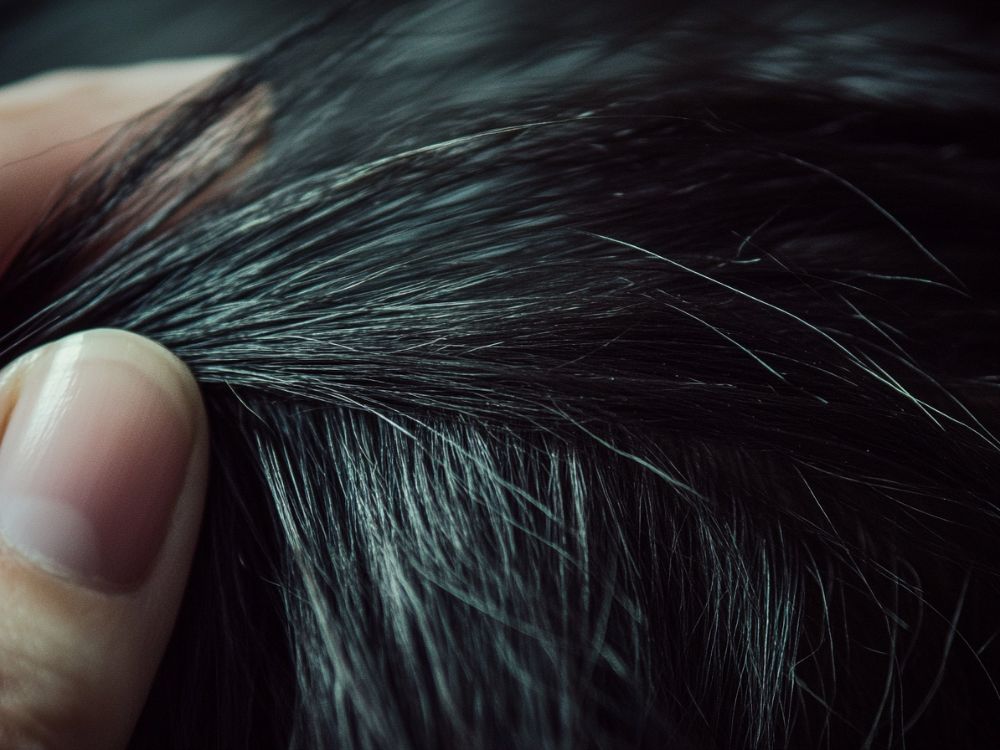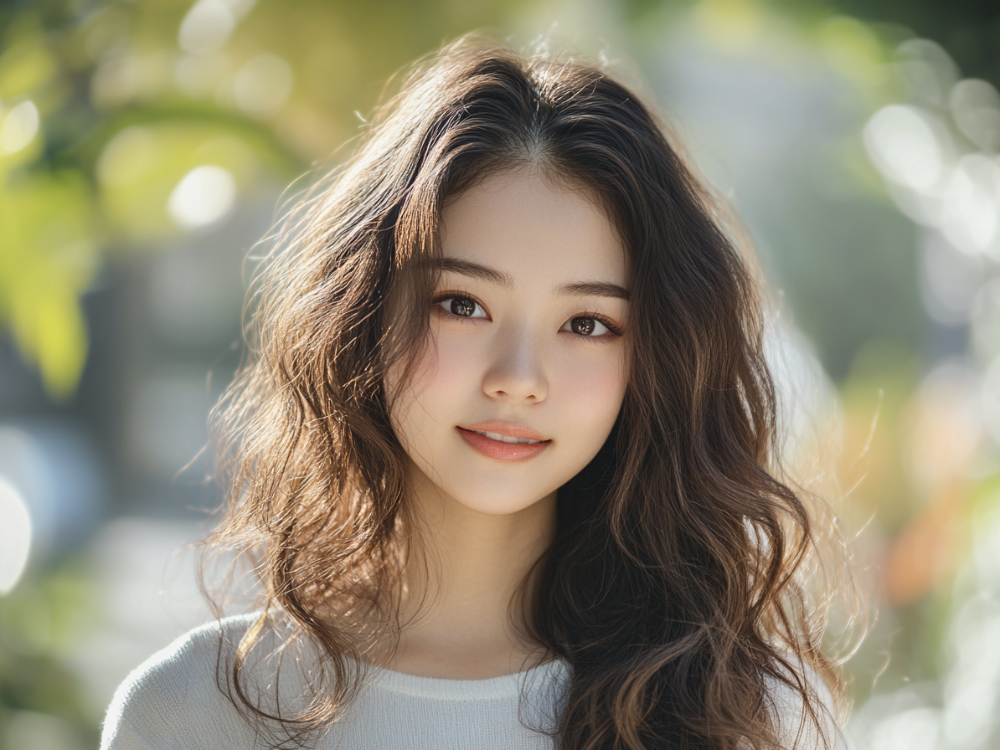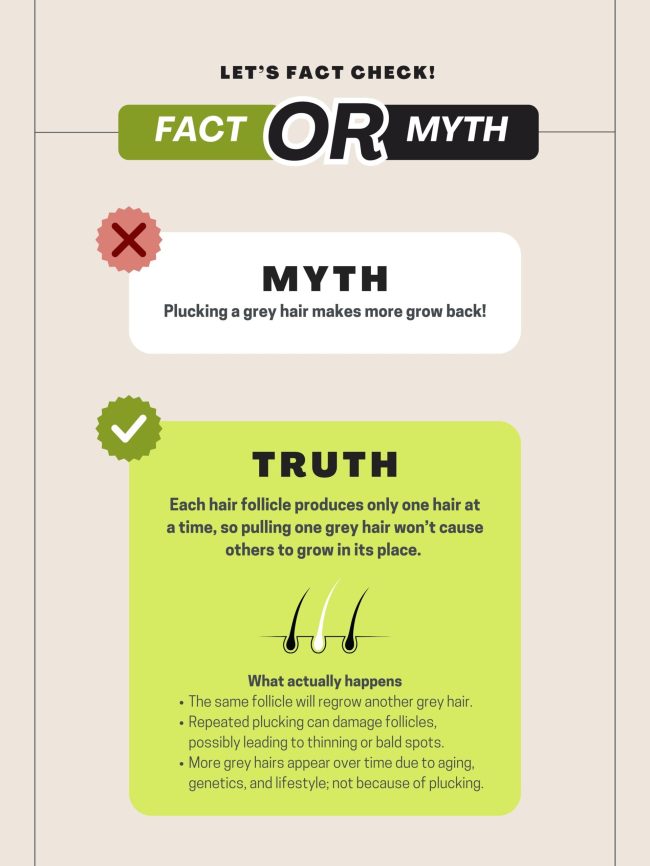
Pulled a Grey Hair? Here’s What Really Happens Next!
POSTED ON March 26, 2025Grey hair is a natural part of the aging process, but spotting a single grey strand can be surprising. Many people instinctively reach for tweezers to remove it, but have you ever wondered what happens when you pull a grey hair? Is it harmless, or could it have unintended consequences?
In this article, we explore the effects of plucking grey hairs, debunk common myths, and provide insights into caring for your hair as it undergoes this natural transition.
Understanding Grey Hair
Hair color is determined by melanin, a pigment produced by melanocytes in hair follicles. As we age, these melanocytes produce less melanin, leading to the gradual transition from colored to grey or white hair. This process varies among individuals, influenced by genetics, environment, and lifestyle factors.

Pigmented Hair
Hair Shaft: This is the visible part of your hair that you see above the scalp. It’s made up of a protein called keratin.
Hair Follicle: The hair follicle is the tiny tube in your skin that holds the hair root. It’s where the hair grows from.
Dermal Papilla: This is a small area at the base of the hair follicle that provides nutrients and signals to the growing hair. It helps control the growth of the hair.

White/ Grey Hair
Hair Matrix: This is the part of the hair follicle where the hair cells rapidly divide and grow to form the hair shaft. It’s responsible for creating the new hair.
Melanocyte: These are special cells in the hair follicle that make melanin, the pigment that gives your hair its color.
Melanin: Melanin is the pigment responsible for the color of your hair. When you’re younger, your melanocytes produce a lot of melanin, giving your hair its natural color. As you age, these cells produce less melanin, which is why hair turns grey or white.
What Happens When You Pull a Grey Hair?
It’s common to feel the urge to remove grey hairs, especially when they appear prematurely or in noticeable areas. However, understanding the implications of plucking is essential.
Regrowth of a Grey Hair: Each hair follicle produces only one hair at a time. When you pluck a grey hair, the follicle will eventually grow a new hair, which will also be grey. This is because the underlying cause of greying (reduced melanin production) remains unchanged by plucking. (UMAS Health, 2019)
Potential Damage to Hair Follicles: Repeatedly plucking hairs can cause trauma to the hair follicle, potentially leading to permanent hair loss in that area. Damaged follicles may not produce hair at all, or the hair that regrows may be thinner and weaker. (Limmerhtc, 2022)
Risk of Infection and Other Issues: Plucking can expose the hair follicle to bacteria, increasing the risk of infection. It can also lead to ingrown hairs, skin irritation, and follicle damage, all of which can affect the overall health of your scalp and hair. (Healthshots, 2023)
Debunking Common Myths About Plucking Grey Hair
Myth 1: Plucking One Grey Hair Causes More to Grow
This is a myth. Plucking a single grey hair does not cause more grey hairs to appear. Hair follicles work independently, and plucking one does not influence the others.
Myth 2: Plucking Grey Hair Will Reverse the Greying Process
Plucking a grey hair does not reverse the greying process. When you pluck a grey hair, the follicle will continue to produce new hair, but the new hair will usually grow in with the same characteristics as the previous one. If the hair was grey, the new hair will most likely be grey as well.
The color of your hair is determined by pigment cells in the follicle, and plucking doesn’t alter that process. Once the melanocytes (the cells responsible for producing hair pigment) slow down or stop producing melanin, the hair is unlikely to return to its original dark color.
Recommendations for Dealing with Grey Hair
Instead of plucking, consider the following approaches:
- Gentle Cutting: If a grey hair is particularly bothersome, carefully trim it with sanitized scissors. This avoids the potential risks associated with plucking.
- Embrace and Care for Grey Hair: Grey hair can be beautiful and unique. Use moisturizing shampoos and conditioners designed for grey hair to keep it healthy and vibrant.
- Consult a Professional: If you’re considering color treatments or other interventions, consult with a professional hairstylist or dermatologist to ensure safe and effective options.
While the sight of a grey hair can be startling, plucking it is not a recommended solution. It does not prevent more grey hairs from appearing and can lead to various scalp and hair issues. Embracing your natural hair color and caring for it properly is the healthiest approach as you navigate the changes that come with aging.
Book An Appointment
Book your FREE consultation today and get personalized advice just for you!
Related
Articles

7 Powerful Benefits of Pre-Chemical Protection for a Healthier, Happier Scalp!
Pre-Chemical Protection for a Healthier Scalp During Hair Treatments When undergoing chemical hair treatments like coloring, bleaching, or relaxing, your scalp can be exposed to harsh chemicals that may cause irritation, dryness, or allergic reactions. Using a pre-chemical protection product, such as a scalp protector, creates an invisible barrier on your scalp, reducing direct contact […]
READ MORE
6 Best Types of Hair Perm for Different Face Shapes: Find Your Perfect Look
Discover the 6 best types of hair perms for different face shapes! From beach waves to spiral curls, find the perfect perm style to enhance your features and transform your look.
READ MORE
The Science of Hair Growth and Why You Should Care
Achieve healthy hair growth with expert scalp care and treatments at De Arte Hair Salon. Discover the science of hair growth and unlock your hair’s full potential!
READ MORE
